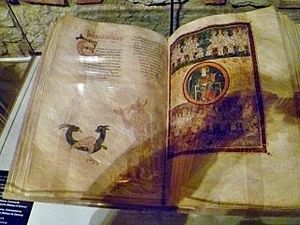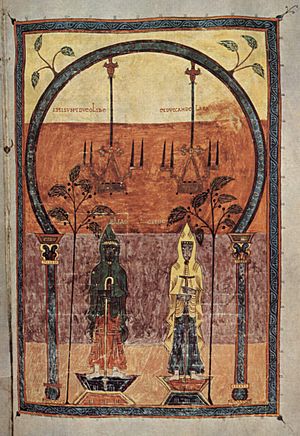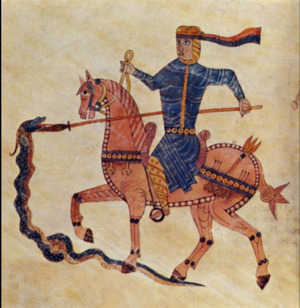Gerona Beatus facts for kids
The Gerona Beatus is a 10th-century illuminated manuscript currently housed in the museum of Girona Cathedral, Catalonia, Spain.
The manuscript contains two separate documents: the Commentary on the Apocalypse by Beatus of Liébana, a late eighth-century manuscript popular in medieval Spain and Jerome's commentary on the Book of Daniel. It includes 284 extant folios, each measuring 400 mm by 260 mm, copiously illustrated with 184 surviving miniatures, and has been described as one of the most richly decorated of the Beatus Commentaries, and one of the best documented.
History
From inscriptions at the conclusion of the text, it is clear that the manuscript was commissioned by an Abbot Dominicus, and was completed on July 6, 975, most probably at the monastery at Tábara. The scribe is identified as Presbyter Senior, and, unusually, the names of its two illuminators are included: Ende pintrix et dei aiutrix - 'Ende, woman painter and servant of God' and 'Emeterius, monk and presbyter'.
Style
The manuscript is described as containing:
... a heavily ornamental spirit, a strong tendency to the two-dimensional, a stylized approach to concrete reality which had an almost surreal air, and an unbroken luminous quality to the paint, all of them qualities we can find in a similar fashion in numerous other Mozarabic Beatus manuscripts too... certain details, such as the robes worn by a horseman or the bridle of a horse, still betray Islamic features.
Several of the manuscript's images indicate an extensive knowledge of Islamic iconography, despite the general style reflecting artistic developments in northern Europe. It has been suggested that this indicates the purpose of the original Commentaries was in opposition to Islamic rule, and a direct criticism of the Mozarabs.
Symbolism

The meaning of the symbols and iconography contained within the manuscript have been the subject of much debate.
Most interesting in this context, is an image of a mounted figure, in Islamic dress, spearing a snake. The meaning of the rider is part of a larger debate, taking place since the early 1990s, over the purpose behind Beatus's compilations and their popularity throughout Christian Spain in the succeeding centuries.
See also
 In Spanish: Beato de Gerona para niños
In Spanish: Beato de Gerona para niños




